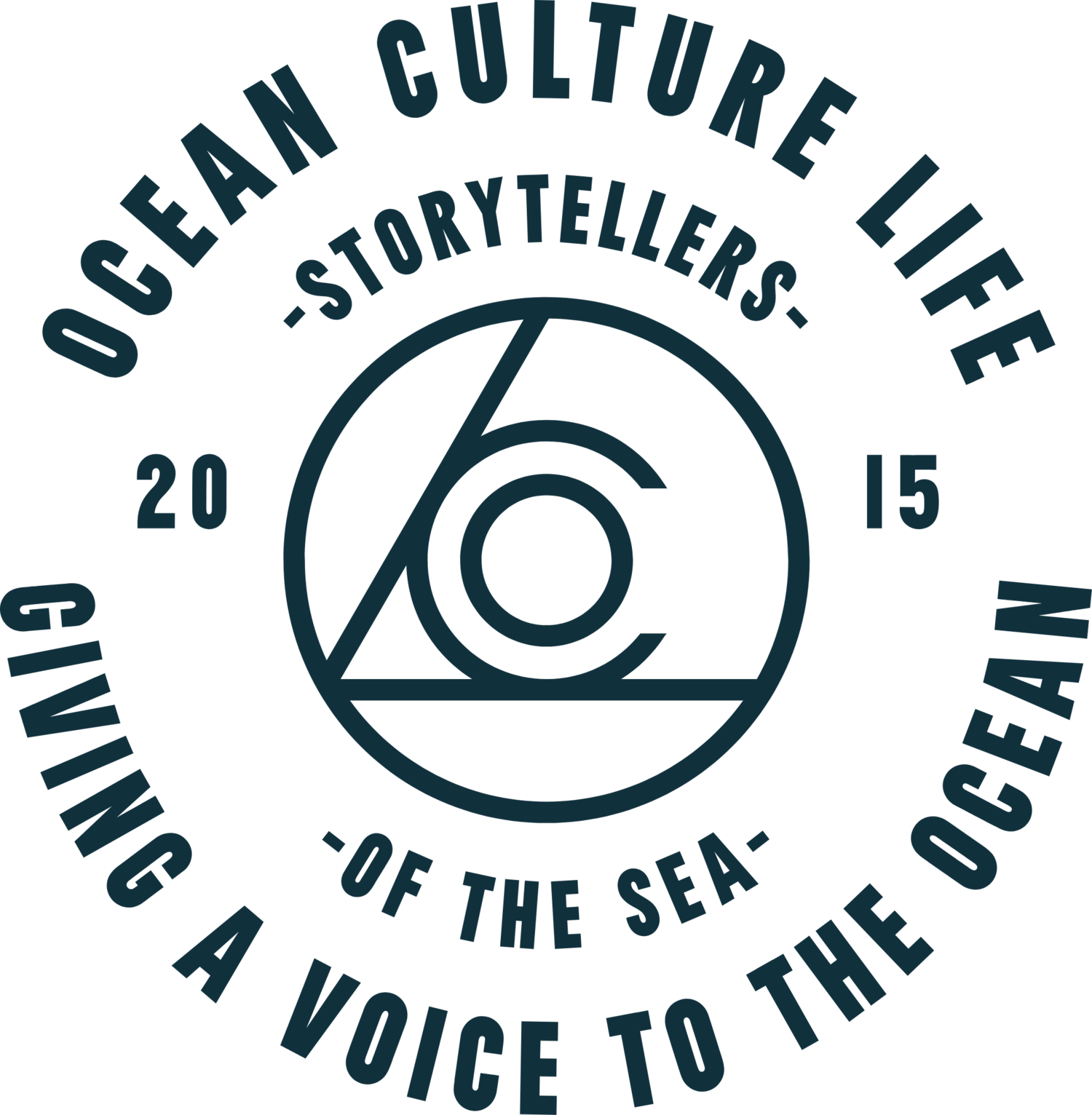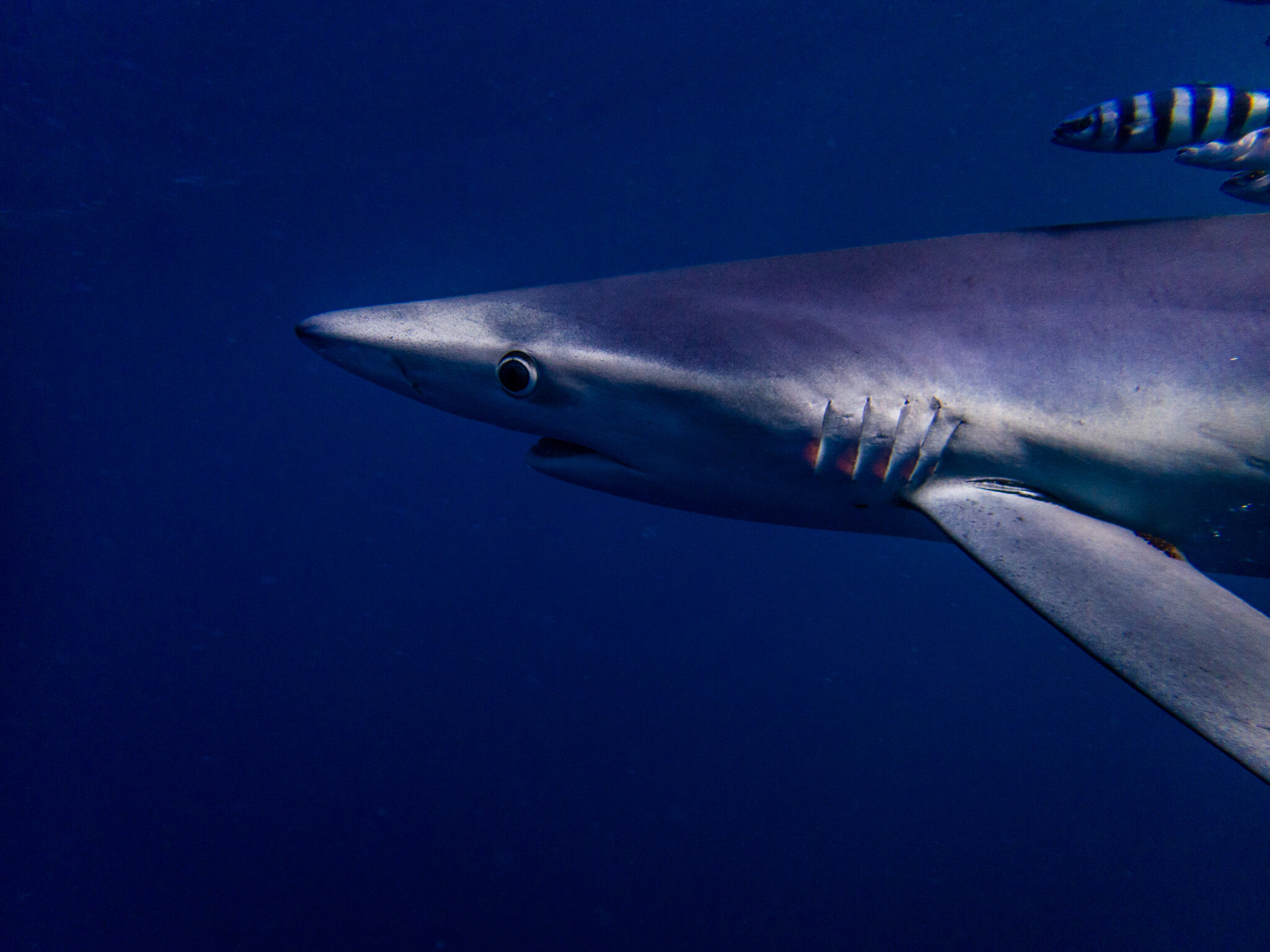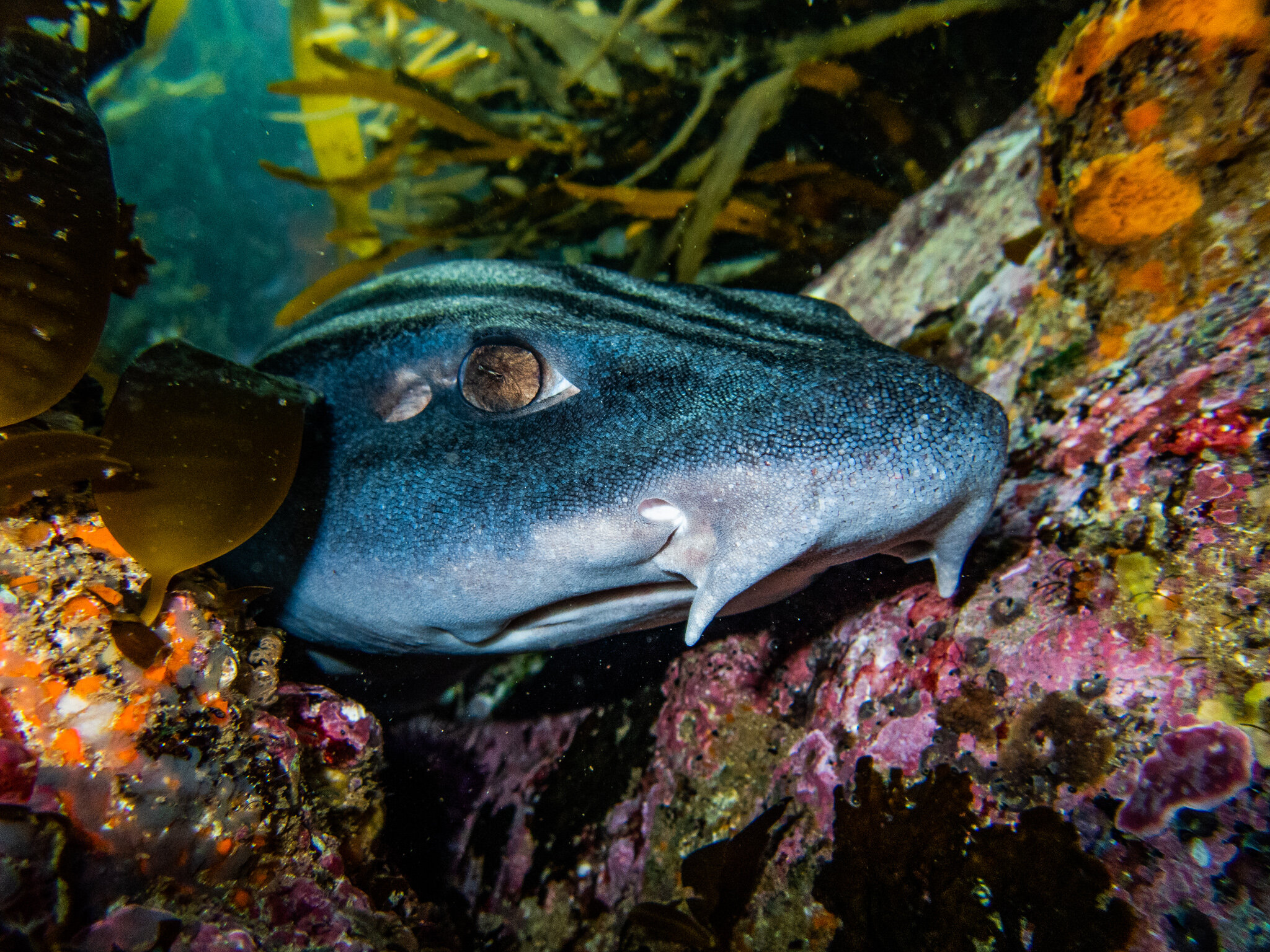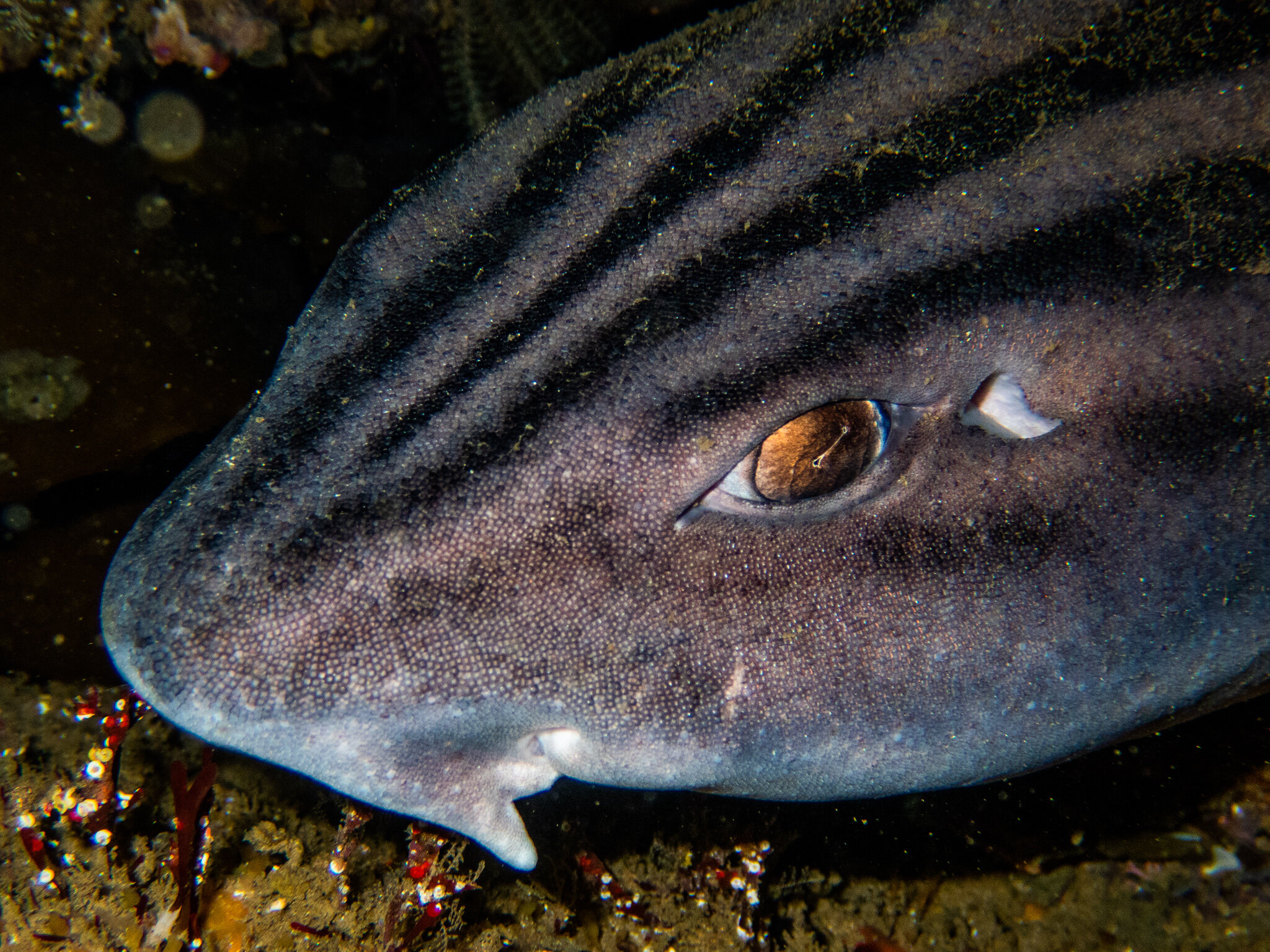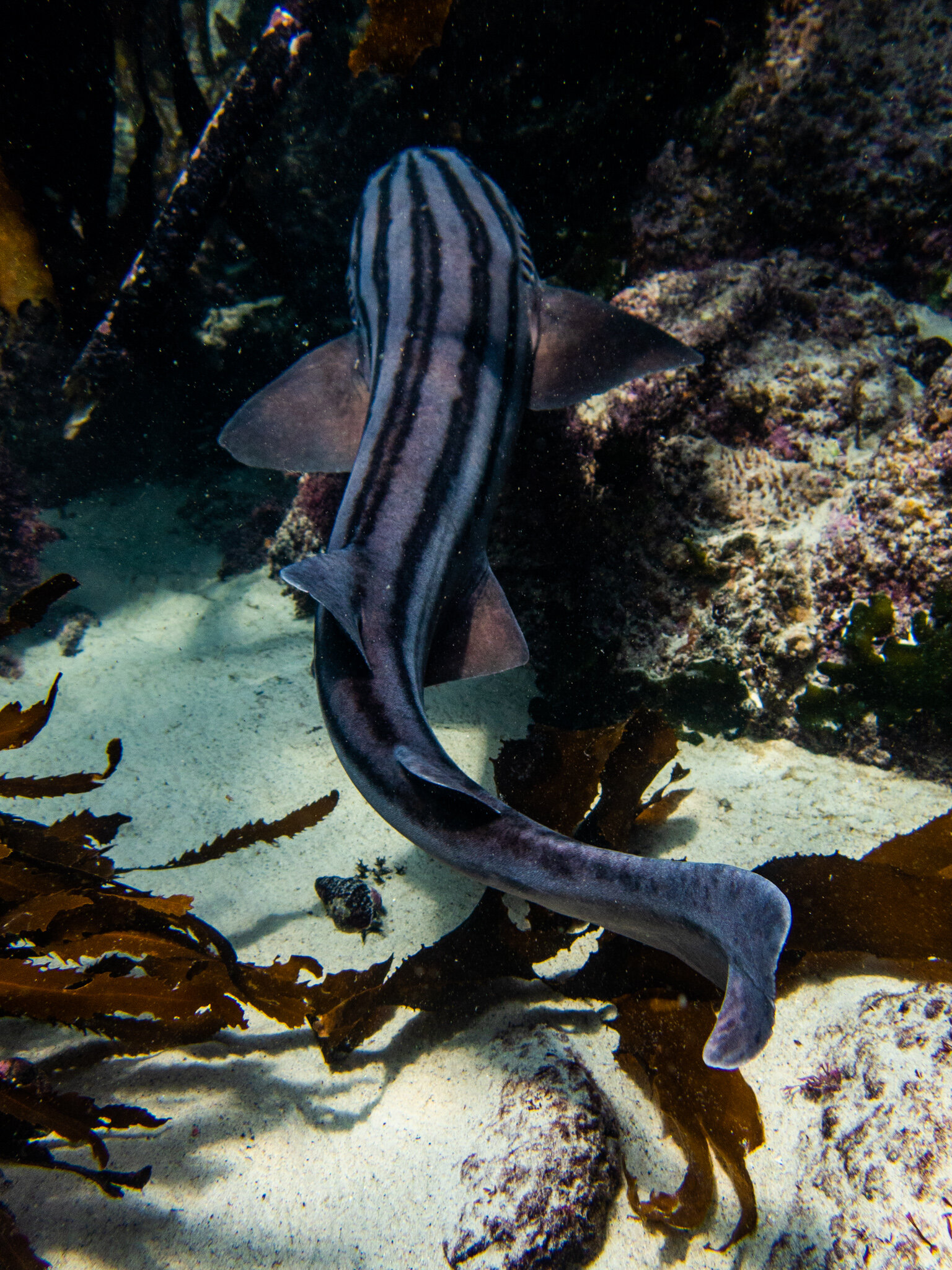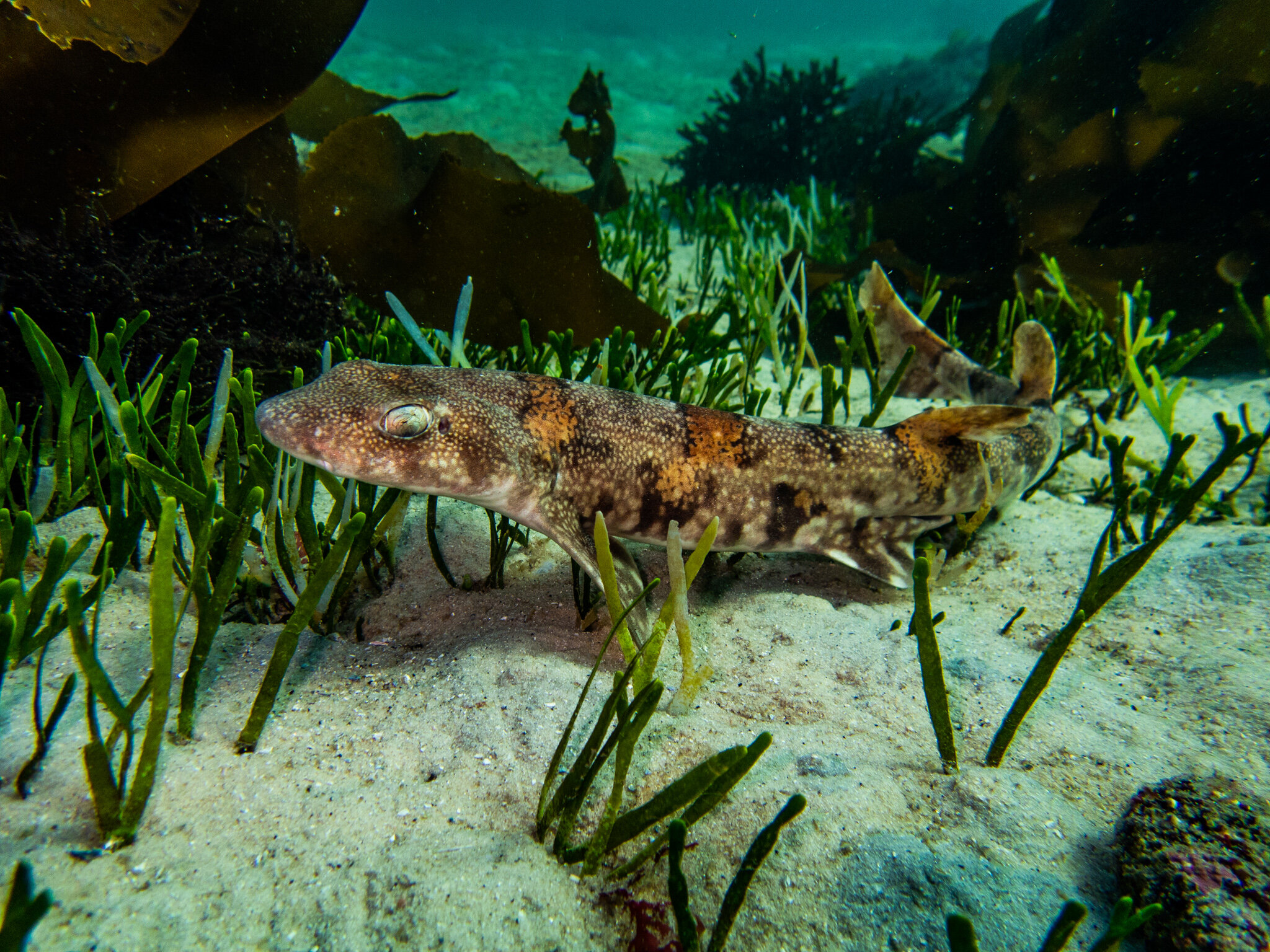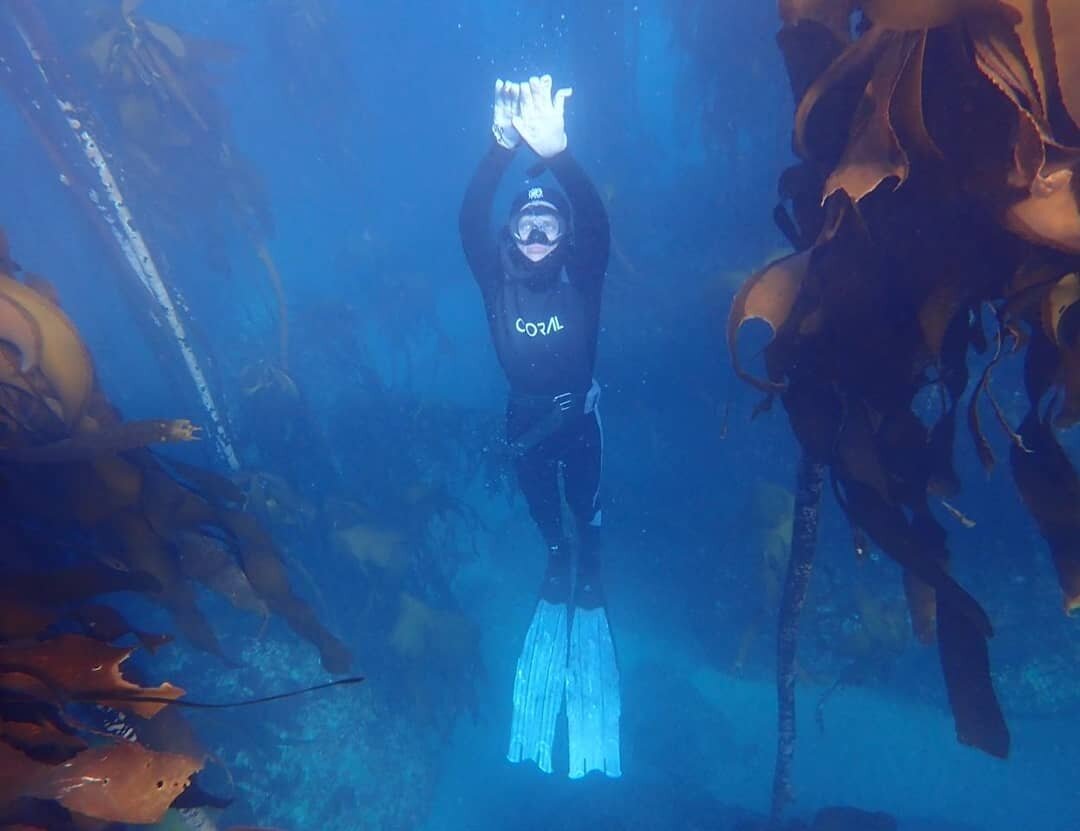In Search of Sharks | Cape Town Africa
Article and Photography by Callum Evans
Ever since my very first time diving in the kelp forests surrounding the coastline of the Cape Peninsula, there is one group of animals that I always make a particularly special effort to look for: sharks. I have been fascinated by sharks for almost my entire life and I love learning about their secretive, fascinating lives and watching them glide effortlessly through the water. Sharks are some of the most important animals in any marine ecosystem, controlling the populations of many species and in doing so, maintaining balance in underwater environments. As research has shown, healthy and diverse marine ecosystems are also incredibly important for the health of all life on land, including us.
My first time ever seeing a shark in the wild was in 2016 on a shark cage-diving trip with Sharklady Operators in Gansbaai. Seven large great white sharks visited the boat over the course of the trip, and when it was my turn in the cage, I got to see these enormous and iconic sharks up close in their natural environment, a dream come true for me. It was another year before I saw my next shark species, a puffadder shyshark on my first attempt at snorkelling in the kelp forests surrounding Cape Town. And it was another 2 years later, when I started scuba diving, that I was able to see sharks again, with the pyjama shark leading the way. Having started scuba diving and later freediving, I was now able to explore the kelp forests that surround the coastline of the Cape Peninsula and very soon, the search of sharks became the dominant driving force behind the majority of my dives.
The kelp forests shelter several shark species that are very different from their larger cousins that roam the open oceans. Aside from their smaller size, many of these species do not have the characteristic dorsal fin that has become such an iconic and feared feature of sharks. Many of these same species can also have quite striking patterns on their bodies, which help them to blend into their environment. In total, nine species of sharks can be seen in the kelp forests, namely puffadder shyshark, dark shyshark, pyjama catshark, leopard catshark, tiger catshark, spotted gully shark, smoothhound shark, St. Joseph’s shark, and seven-gilled cowshark. Of these nine, only the cowshark and St. Joseph’s shark has eluded me so far and of the other species, I see five of them on a regular basis (tiger catsharks and smoothhound sharks are very elusive). In addition, I have also seen four species of rays here, the close relatives of sharks. The giant short-tailed stingray, with a wingspan over two metres wide (and over 300kg), is the species most commonly encountered in False Bay and it is something truly special to swim along an animal of that size. I have also seen the diminutive onefin electric ray, the Atlantic electric ray and the bizarrely shaped and incredibly camouflaged diamond ray.
Of all these sharks, the pyjama shark is undoubtedly my favourite shark to encounter while diving. There is something truly special about alongside one of these striking sharks as they patrol the kelp forests in search of prey. Their black and grey striped markings that run the length of their bodies easily distinguish them from the other shark species. However, they can still be quite tricky to find, as they often prefer to spend the daylight hours sleeping in caves or in large cracks in the rocks. Peering into these shelters, one can sometimes find six or seven sharks piled on top of each other, conserving their energy in what sometimes looks like incredibly uncomfortable sleeping positions. They also use these shelters to hide from predators, including Cape fur seals and cowsharks. While resting, they still pump water over their gills by opening and closing their mouths. They often hunt at night, preying on octopus, rock lobsters, crabs, molluscs and fish, but also regularly move around during the day. The largest individuals can be just over a metre long, so it can be quite a surprise to come face-to-face with one that size when diving down into the kelp! Their close relatives, the leopard catsharks, are significantly smaller and much harder to find, so it is always incredibly special to spot one of these sharks hiding in a crack or swimming around. They are just as striking as the pyjama’s, covered in dark rosettes and spots that give this species its name.
The smaller species of sharks, the puffadder and dark shysharks, can pose an even greater challenge to find than the pyjama sharks because the markings on these two species allow them to blend in superbly to their surroundings. They have an impressive (and sometimes annoying ability) to disappear like ghosts into the kelp forests as soon as you have spotted them. However, every now and then, they stop swimming and take a break on the sandy clearings on the forest floor, allowing the chance to lie next to them and photograph them in detail. The puffadder shyshark has probably the most complex markings of all the local sharks, which orange and brown saddle-like blotches on their backs and hundreds of lightly coloured spots and dark scribbles. The orange markings give this shark its name, as they bear a striking similarity to the markings of the puffadder snake. The slightly bigger dark shyshark usually has varying shades of brown colouration over its body. Both species are able to weave their way through thick stands of kelp and tight cracks in rocks in search of small prey.
Another larger shark can often be much harder to find than the other species. It used to have an almost mythical status for me when I started diving, as I could never find them. They can vanish in amongst the kelp with ease despite its size. Then, over six months after I started freediving, I found my first spotted gully sharks. Perhaps some of my most memorable diving moments have been encountering large aggregations of these beautiful animals, which often occur during the breeding season. Unlike the catsharks and shysharks, spotted gully sharks have a large dorsal fin, giving them the stereotypical ‘shark-shape’. They can reach lengths of up to 2 metres long, making them some of the largest inhabitants of the kelp forest. They cruise just above the sea floor, slowly searching for octopus, small fish and lobsters, but they are incredibly agile and fast swimmers, able to put on an impressive turn of speed (vital for hunting as well as escaping danger). They can appear intimidating, but they are harmless to people. I have had them swim barely a couple of centimetres from me and the sharks barely gave me a second glance. In fact, they will shoot away into the kelp if they feel even the tiniest bit threatened by us.
However, these sharks are far from the only species that are found in the oceans around Cape Town. In fact, South Africa’s coastlines are one of the top three global hotspots for shark and ray diversity, with 204 different species recorded (one third of the global diversity), of which 69 species are endemic to South Africa (including the pyjama catshark and puffadder shyshark). The Kwa-Zulu Natal coastline in particular have a number of important aggregation sites (including Protea Banks) for several shark species, including ragged-tooth sharks, scalloped hammerheads, bull sharks and guitarsharks, and whale sharks, manta rays and tiger sharks also move up and down this coastline too. The Southern Coastlines have also been famous for any years as being an important hotspot for great white sharks. In False Bay, many other shark species also visit at certain times of the year either to feed or breed, including bronze whaler, smooth hammerhead and thintail thresher sharks. In the open oceans just south of Cape Point, mako sharks and blue sharks patrol the ocean currents.
Earlier this year, I was lucky enough to go on a pelagic shark dive with Shark Explorers (one of the dive operators based in Simon’s Town) and had the incredible privilege of scuba diving in the open oceans south of Cape Point with a male blue shark. The most abundant shark on the planet, these ocean wanderers patrol every ocean in search of fish and squid. Their large eyes give them the ability to pursue squid in deeper waters or at night. This shark was very relaxed with our presence and what’s more, he was very inquisitive, swimming past each of us in turn throughout the dive and inviting us to interact with him. He was also very big for his species, well over 3 metres long. The long pectoral fins of these sharks almost resemble the wings of a plane and their long, streamlined bodies make them well adapted for efficiently travelling large distances in search of food.
As incredible as this encounter was, there was nonetheless signs around us of how much the oceans have changed in the past few decades. The dive masters told us how they used to see up to 30 blue and mako sharks on their dives 10/20 years ago and now they usually only see only 3 or 4 sharks at best. We also did not see any fish that day, aside from the pilot fish following the blue shark. This is just one example of the astronomical impact that commercial fisheries are having on our oceans. Blue sharks are one of the most heavily fished sharks in the world. They often caught as bycatch by commercial trawlers but also increasingly, shark fisheries are intentionally targeting them in order to feed the demand for shark fin soup. Many other species of ocean-going sharks and rays are also under constant from legal and illegal fisheries, even giants like the whale shark. Even the species that I regularly encounter in the kelp forests are not safe. Spotted gully and smoothhound sharks are regularly caught by the legal shark fishing industry in South Africa, then sold to countries like Australia and the UK where they are served as flake and chips. The tiny puffadder shyshark is now been classified as Endangered on the IUCN Red List (along with a number of other shark species). Even the numbers of great whites have plummeted in the last 30 years. With over 100 million sharks killed every year and with the oceans under increasing threat from climate change and various forms of pollution, every single species is under severe pressure.
Sharks have all but disappeared in many parts of the oceans, with the ecosystems there suffering as a result of their absence. These declines have happened during my lifetime and I have even seen changes in False Bay, including the disappearance of great whites from the area. However, I have also seen a shift in many people’s perceptions of sharks. More and more people I meet want to see sharks in the wild and they cannot imagine an ocean without them. The pyjama shark has recently gained some significant recognition from it being featured in the Oscar winning documentary My Octopus Teacher, which drew much needed awareness to the kelp forests of Cape Town. Local organisation like Shark Spotters and CapeRadd do important work in the research and conservation of the shark populations in False Bay. Sharks also generate significant revenue with thousands of people going out with dive operators in South Africa every year to dive with sharks. There are stories of hope across the world too, where shark numbers have bounced back in Palau and Raja Ampat, proof of the resilience of these animals if they are safe from persecution. Sharks have been swimming in the world’s oceans for over 400 million years, surviving all five mass extinction events, and now they are under serious threat of being wiped up by us. There is still so much that we don’t know about sharks, but we do know that they are critically important to the health of our oceans and in turn, the health of our planet. For me, sharks the idea of an ocean without them is too. One day, I hope to dive with tiger sharks, whale sharks, hammerheads and manta rays, but it will always be the elusive and unobtrusive sharks of the kelp forests and cold waters off Cape Town that first inspiring my love of diving and the ocean. The shysharks, catsharks and gully sharks that patrol the African sea forest will forever hold a special place in my heart and I will always return to False Bay to search of them.
Article and Photography by OCL Storyteller Callum Evans
Callum Evans | Photographer | Freediver | South Africa
Instagram - @callumswildlifephotography
